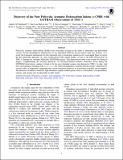| dc.contributor.author | Burkhardt, Andrew M | |
| dc.contributor.author | Long Kelvin Lee, Kin | |
| dc.contributor.author | Bryan Changala, P | |
| dc.contributor.author | Shingledecker, Christopher N | |
| dc.contributor.author | Cooke, Ilsa R | |
| dc.contributor.author | Loomis, Ryan A | |
| dc.contributor.author | Wei, Hongji | |
| dc.contributor.author | Charnley, Steven B | |
| dc.contributor.author | Herbst, Eric | |
| dc.contributor.author | McCarthy, Michael C | |
| dc.contributor.author | McGuire, Brett A | |
| dc.date.accessioned | 2022-03-10T15:13:30Z | |
| dc.date.available | 2022-03-10T15:13:30Z | |
| dc.date.issued | 2021 | |
| dc.identifier.uri | https://hdl.handle.net/1721.1/141108 | |
| dc.description.abstract | <jats:title>Abstract</jats:title>
<jats:p>Polycyclic aromatic hydrocarbons (PAHs) have long been invoked in the study of interstellar and protostellar sources, but the unambiguous identification of any individual PAH has proven elusive until very recently. As a result, the formation mechanisms for this important class of molecules remain poorly constrained. Here we report the first interstellar detection of a pure hydrocarbon PAH, indene (C<jats:sub>9</jats:sub>H<jats:sub>8</jats:sub>), as part of the GBT Observations of TMC-1: Hunting for Aromatic Molecules (GOTHAM) survey. This detection provides a new avenue for chemical inquiry, complementing the existing detections of CN-functionalized aromatic molecules. From fitting the GOTHAM observations, indene is found to be the most abundant organic ring detected in TMC-1 to date. And from astrochemical modeling with <jats:monospace>nautilus</jats:monospace>, the observed abundance is greater than the model’s prediction by several orders of magnitude, suggesting that current formation pathways in astrochemical models are incomplete. The detection of indene in relatively high abundance implies related species such as cyanoindene, cyclopentadiene, toluene, and styrene may be detectable in dark clouds.</jats:p> | en_US |
| dc.language.iso | en | |
| dc.publisher | American Astronomical Society | en_US |
| dc.relation.isversionof | 10.3847/2041-8213/ABFD3A | en_US |
| dc.rights | Article is made available in accordance with the publisher's policy and may be subject to US copyright law. Please refer to the publisher's site for terms of use. | en_US |
| dc.source | The American Astronomical Society | en_US |
| dc.title | Discovery of the Pure Polycyclic Aromatic Hydrocarbon Indene (c-C9H8) with GOTHAM Observations of TMC-1 | en_US |
| dc.type | Article | en_US |
| dc.identifier.citation | Burkhardt, Andrew M, Long Kelvin Lee, Kin, Bryan Changala, P, Shingledecker, Christopher N, Cooke, Ilsa R et al. 2021. "Discovery of the Pure Polycyclic Aromatic Hydrocarbon Indene (c-C9H8) with GOTHAM Observations of TMC-1." The Astrophysical Journal Letters, 913 (2). | |
| dc.contributor.department | Massachusetts Institute of Technology. Department of Chemistry | |
| dc.relation.journal | The Astrophysical Journal Letters | en_US |
| dc.eprint.version | Final published version | en_US |
| dc.type.uri | http://purl.org/eprint/type/JournalArticle | en_US |
| eprint.status | http://purl.org/eprint/status/PeerReviewed | en_US |
| dc.date.updated | 2022-03-10T14:51:34Z | |
| dspace.orderedauthors | Burkhardt, AM; Long Kelvin Lee, K; Bryan Changala, P; Shingledecker, CN; Cooke, IR; Loomis, RA; Wei, H; Charnley, SB; Herbst, E; McCarthy, MC; McGuire, BA | en_US |
| dspace.date.submission | 2022-03-10T14:51:36Z | |
| mit.journal.volume | 913 | en_US |
| mit.journal.issue | 2 | en_US |
| mit.license | PUBLISHER_POLICY | |
| mit.metadata.status | Authority Work and Publication Information Needed | en_US |
